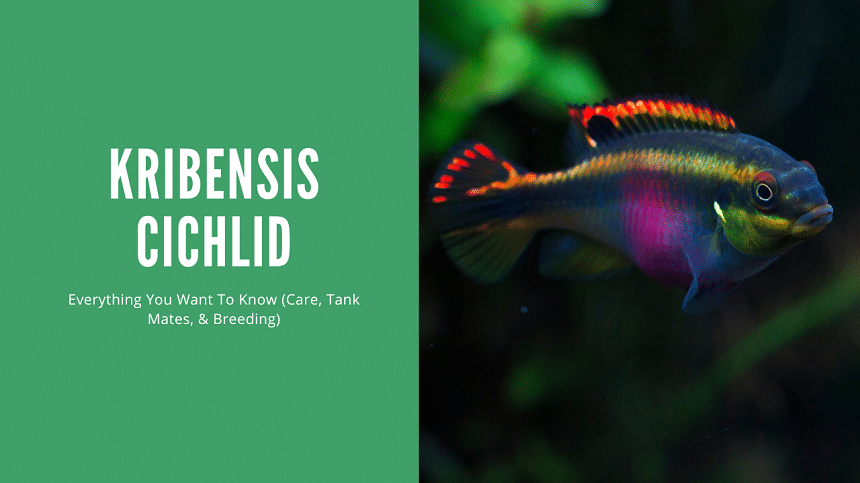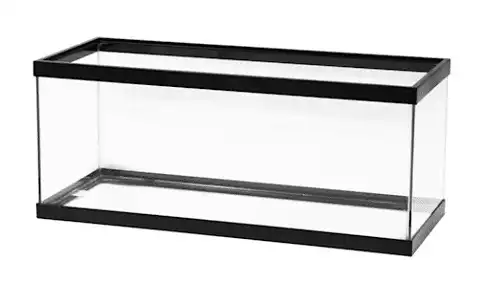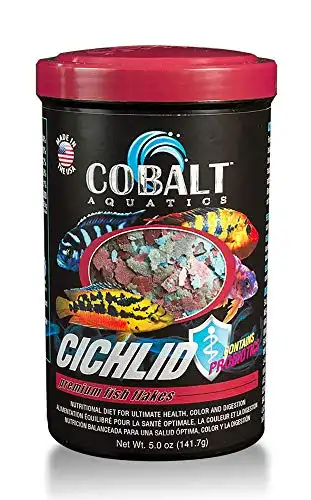Thank you for visiting! By the way… any links on this page that lead to products on Amazon and other stores/partners are affiliate links Aquarium Store Depot earns a commission if you make a purchase.
Bring vibrancy and life to your community tank, the Kribensis Cichlid is a beautiful dwarf cichlid species that is perfect for both novice and expert aquarists. In this thorough guide you will learn all about caring for these freshwater fish as well as how to breed them. With this knowledge, you can confidently make the Kribensis Cichlids part of your own aquarium setup!
Key Takeaways
- They are easy to care for and one of the easiest cichlids to breed in the hobby
- Provide a 20-30 gallon tank with live plants, hiding spots, and well balanced diet to keep them healthy & happy.
- Choose compatible tank mates of similar size. Avoid slow moving or aggressive fish to prevent stress & injury.
Species Overview
| Scientific Name | Pelvicachromis pulcher |
| Common Names | Kribensis Cichlid, Krib, Rainbow Krib, Rainbow Cichlid |
| Family | Cichlidae |
| Origin | West Africa (Ethipe River in the Niger Delta) |
| Diet | Omnivorous |
| Care Difficulty | Moderate |
| Activity | Active |
| Life Expectancy | 5 Years |
| Temperament | Peaceful – but semi-aggressive when breeding and against bottom feeders |
| Tank Level | All |
| Minimum Tank Size | 20 gallons (75 liters) |
| Water Temperature Range | 75-79°F (24-26°C) |
| Water Hardness | 5-12 dKH |
| pH Range | 6 – 7 |
| Filtration/Water Flow | Moderate |
| Water Type | Freshwater |
| Breeding | Oviparous |
| Difficulty to Breed | Easy |
| Compatibility | Community thank with similar sized and temperament fish |
| OK, for Planted Tanks? | Yes |
Introduction
Kribensis Cichlids, also known as Rainbow Kribs or Rainbows Cichlids, are a type of cichlid found natively in Nigeria and Cameroon. With their beautiful colors and calm temperament when kept with other species inside the same community tank, they make an ideal addition to any home aquarium.
Provided that proper care is taken, including appropriate breeding management, these colorful creatures can offer a fulfilling experience by introducing some great interactions. They are also great caretakers of their baby fish!
Origin And Natural Habitat
Kribensis Cichlids, native to the slow-moving waters of Nigeria and Cameroon. In their natural habitat, they prefer dense vegetation for hiding spots and territory. Setting up an environment similar to what would occur naturally will make sure these colorful cichlids are happy within your aquarium.
Appearance
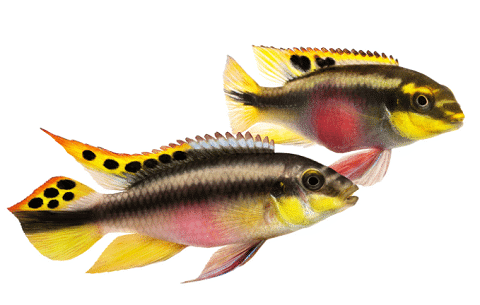
The breathtaking appearance of Kribensis Cichlid makes it an extremely desirable species for any community tank. The males and female kribensis are both quite distinct, with the female boasting a shorter rounder body, while also being more colorful along with pointer dorsal, anal, and tail fins. Their trademark is the pink area around their belly. The male kribensis has larger pointed anal fins, is slimmer, and will grow longer than the female. All together, this creates a visually appealing scence in your freshwater habitat. These differences also make it easy to select a pair to breed when purchasing them at a fish store.
Lifespan
The Kribensis Cichlid is a beautiful, lively fish that can live up to 5 years in captivity with proper care. To extend their life span and keep them healthy, it’s important to provide a balanced diet, clean water conditions, as well as a low stress environment. The great thing about them is they are pretty tolerant of a variety of conditions and get along with many tankmates, so even novices can keep them healthy for a long time.
Average Size
Kribensis Cichlid size varies slightly between males and females. They are a small tropical fish species, with males reaching up to 4 inches and females measuring 3. As they are small, you don’t need too large of a tank to house them. However, they do get aggressive when they are breeding. Have a plan to separate them or consider a larger tank if you want them to care for their young in the display tank.
Kribensis Cichlid Care Guide
For Kribensis Cichlid owners, caring for this small fish includes more than just feeding them. Creating the right environment in their tank and making sure appropriate water parameters are met is essential to providing good care of these cichlids. This section covers all aspects of taking care of kribensis cichlids: from selecting a suitable aquarium size to adding decorations and filtration systems.
All that’s required is finding out what the necessary requirements are, such as substrate types, dimensions, etc. Once those elements have been established, any aquarist can be on his way to building an optimal home for this species! It’s important to stay mindful about keeping up with correct water conditions in order to ensure healthy fishes throughout their lifespan by monitoring ph levels and other readings regularly – given time dedicated towards proper maintenance could result in truly rewarding experiences when dealing with Kribensis communities!
Tank Size And Dimensions
When setting up a tank for Kribensis Cichlids, you should consider an aquarium of at least 20-30 gallons. This will ensure they have plenty of space to swim and set up territories accordingly while also providing room to interact peacefully with other fish living in the same area. A longer tank is always better for these fish as they establish their territories near the bottom of the tank.
A classic 20 gallon aquarium in its 30 inch long variant. A very popular aquarium.
A larger tank will also have more stable parameters and reduces hostility between inhabitants if you decide to get any territorial fish – making way for a much healthier environment within the confines of your home.
Substrate And Decorations
Creating the ideal environment for your Kribensis Cichlids is important in order to ensure their welfare and joy. Incorporate fine gravel or sand, which reflects its natural habitat accurately. If you choose sand and want to keep plants, you will either want to cap the sandbed with sand or have separate sand and planted substrate sections. Live plants will enhance water quality as well as provide shelter for these fishes if used within the tank of a kribensis cichlid set-up. Here are some great beginner plants to try with them:
- Java Fern
- Anubias
- Java Moss
- Subwassertang
- Bucephalandra
Hiding places such as hollow coconut shells or driftwood have great significance when it comes to providing protection and security along with giving breeding couples a suitable place to lay eggs safely. Position these accessories near the periphery of the aquarium while making sure they are placed wide apart from one another so that each fish can easily create an individual area.
Editor's Choice
Manzanita offers it all. Great shape, low tannins, quick to water log and reasonably priced. It's the ultimate driftwood!
Water Parameters
Ensuring your Kribensis Cichlids are living in a secure and healthy environment requires stable water parameters. For optimal results, it is recommended to keep these parameters between 75-79°F for temperature with pH from 6.0 – 7.0 and hardness levels ranging from 5-20 dGH, respectively. Test kits should be used regularly to detect any changes that might impact the health of your fish, thereby allowing you to make timely adjustments as required so they live their best lives free of stress or sickness caused by sudden shifts in chemistry variables. Always test for these other key parameters as well, and consider doing water changes if you are off from these recommended levels.
Filtration
A reliable filtration system is essential to keep the water clean and avoid any illnesses in your Kribensis Cichlid tank. Canister filters are ideal in a planted and a community tank environment because they provide efficient biofiltration and maintain stable conditions.
The Pro's Choice
The top choice among professional aquascapers. German engineering and equipped with an intregrated heater.
To guarantee proper operation, remember to regularly check on your filter unit and replace any worn-out components as needed. For a breeding situation, a separate breeding tank with a sponge filter works best as it is gentle enough to be used safely around fry.
Diet And Feeding
Kribensis Cichlids need a balanced diet to keep their color scales and healthy energy. This consists of sinking pellets, frozen or freeze-dried foods, and small amounts of veggies.
With probiotics and specially formulated for Cichlids, this is bar none the best flake formula available for your Africans
To keep these fish healthy, feed them properly once daily, offer them tropical flakes combined with cichlid pellets plus occasional treats such as brine shrimp or bloodworms. It’s important that uneaten food be cleared away in order to maintain water quality. Frozen foods can be used as well to enhance diet. Bloodworms and frozen brine shrimp are usually the food of choice when it comes to frozen food.
Behavior And Compatibility
Kribensis Cichlids are usually quite gentle and non-aggressive, making them suitable for keeping with various tankmates. However, when it comes to breeding time, they will become territorial over their hideaways or caves. There have been cases posted on fish forums about how all the other fish in the community fish tank would hang out at the edges of the tank after the Kribensis cichlids started to breed in order to avoid their aggression.
Suitable Tank Mates
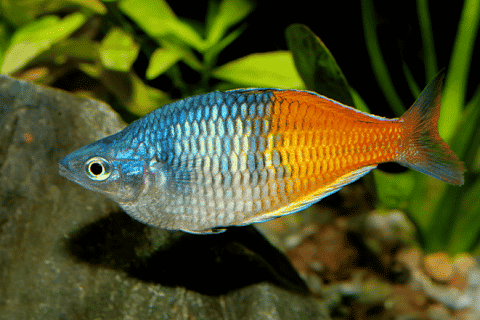
When looking for suitable tankmates to house with Kribensis Cichlids, peaceful fish species that are of similar sized such as:
- Harlequin rasboras
- Plecos
- Tetra schools
- Small barbs
- Molly Fish
- Swordtails
- Rainbowfish
- Small freshwater catfish
- Surface dwelling and mid-water fish
All these fish are perfectly compatible with the Kribensis cichlid when they are not breeding. However, have a backup plan in the event that dominates the entire tank during this time. The best way to curb this aggression is to temporarily remove the Kribensis Cichlids into a breeding tank until the young have been raised.
Bad Tank Mates

It is not recommended to keep Kribensis Cichlids with timid fish, fish that will fit in its mouth, or overly aggressive fish. To keep with research, here are some obvious examples of fish to avoid:
- Large cichlids
- Tiger barbs
- Most bottom dwellers – Kribs establish territory at the bottom and will attack fish occupying its space
- Invertebrates – Kribensis Cichlids will happily eat most shrimps and harass snails and large inverts
- Betta fish – Good chance of getting killed when Kribs are breeding
- Fish that do not have similar water requirements, like Goldfish
- Slow moving fish like Discus Fish.
One thing to note about Kribensis cichlids is when breeding. These fish are such dedicated parents that they will attack fish much larger than them and will happily sacrifice their lives in defense of their youth. Even if the more aggressive fish wins out, it may be wounded enough to be subject to infections. Do not underestimate your kribensis cichlid’s ability to defend its young and breeding grounds!
Breeding And Fry Care
Breeding Kribensis Cichlids is an enjoyable activity that can be relatively simple. To ensure successful breeding, it’s necessary to set up a separate tank of at least 20 gallons for the process. Water conditions should also be modified, and care must be taken when dealing with eggs and fry in order to achieve optimal results. We have a video from The Urban Fishkeeper that shows his process how he breeds this fish.
Taking these steps will increase your chances of success when attempting to breed kribensis cichlids!
Caring For The Fry
For your Kribensis Cichlid fry to receive the best care, keep these points in mind: First off, you should ensure a suitable tank size of at least 20-30 gallons and maintain an ideal water temperature between 75-79°F. It is also important that pH levels remain balanced from 6 to 7. You should have sufficient food sources like liquid fish food, baby brine shrimp, or powdered foods available throughout each day so they can grow healthy and strong. Doing regular water changes is necessary, too, since it will help prevent diseases while keeping the quality high within this ecosystem for them over time.
The fry rearing process is one of the most rewarding experiences in the aquarium trade to have with Kribensis cichlids. Once the eggs hatch, they are one of the most devoted parents and couples you will find in the aquarium hobby. Not only are they fierce defends of their young, as we mentioned previously, but they also work together to raise their young. They will continue to raise their young until they are old enough to fend for themselves. When the young are ready, the parents will chase them away from their territory so they can establish their own territories.
The couple will continue to say together, being completely monogamous and dedicating themselves to being together and raising more young. They will dedicate themselves to each other for life, staying together until one of them dies.
That being said, there is a chance that the fish batch may get eaten by the parents. This sometimes happens as the parents are new. Don’t be disappointed if this happens with the first batch. Subsequent batches should be more successful. It’s not common for the couple to have multiple fry batches during their lifespan together. Make sure you have a plan to house the young once they are old enough to be on their own.
Common Diseases
Kribensis Cichlids are quite resistant to illness, though they can still contract common freshwater fish diseases which affect freshwater fish. Examples of these include Ich (also known as white spot disease, characterized by spots on the body and fins), Dropsy caused by bacteria infections, and Fin Rot resulting from bacterial infections or fungus.
To prevent any spread or onset of such illnesses, it is important that one monitors their tank’s water conditions regularly alongside routine maintenance. If symptoms do occur, then isolating affected creatures while treating the entire aquarium with necessary medicines would be essential in protecting Kribensis Cichlid health. Seeking advice from a vet or experienced fish keeper should also be considered for accurate prescription medications so as to keep them safe from being impacted negatively by pathogens present within freshwater habitats.
A best practice is to quarantine fish, but I understand that many freshwater hobbyists do not do this practice. Always try to purchase from a reputable local store or an online store. Most stores should have a guarantee on their fish.
Frequently Asked Questions
How many Kribensis should you keep together?
To help promote peaceful interaction in your tank, it is advised to keep kribensis in a group or pair composed of more female kribensis cichlids than males. This will enable you to dodge any hostile behavior such as fin nipping that may arise from the fish.
Are Kribensis good community fish?
Kribensis are a great choice for any community tank due to their peaceful temperament and compatibility with many other species. As such, they make an ideal addition to virtually every type of community aquarium setup. However, keep in mind that they will become aggressive when they start breeding.
Can you keep just one Kribensis?
Having a pair of Kribensis is very desirable because they present stunning colors when they are together. You can still have one by itself if desired.
What cichlids can I keep with Kribensis?
It is best to not add any other cichlids when keeping Kribensis. They will fight with many dwarf cichlids like Apistogrammas in the same tank. Many other cichlids are too large for them, like New World cichlids. Others are too aggressive, like African cichlids. Your best bet with a Kribensis cichlid is a Severum.
What is the ideal tank size for Kribensis Cichlids?
Kribensis Cichlids need a tank size of around 20-30 gallons for them to feel completely at home. Such an environment is essential in order to make sure they thrive and be comfortable in their habitat. Longer is better, and having a large tank will help with aggression when it comes time for breeding.
Closing Thoughts
Kribensis Cichlids bring bright colors and activity to any community tank. To ensure a long life in your aquarium, provide suitable tank setup parameters like temperature and pH balance, offer them an assorted diet, and keep compatible fish as companions. And follow the detailed care guide referenced here. Doing so will help you create a healthy environment for these freshwater beauties that all can enjoy!
Have you kept a Kribensis cichlid before? Let us know your experience in the comments below. We love to hear from our readers. Until next time!
- About the Author
- Latest Posts
I’m thrilled that you found Aquarium Store Depot! Here you’ll find information on fish, aquariums, and all things aquatics related. I’m a hobbyist (being doing this since I was 11) and here to help other hobbyists thrive with their aquariums! I adhere to a high quality Editorial Process and Review products with real life field usage and practical analysis.

